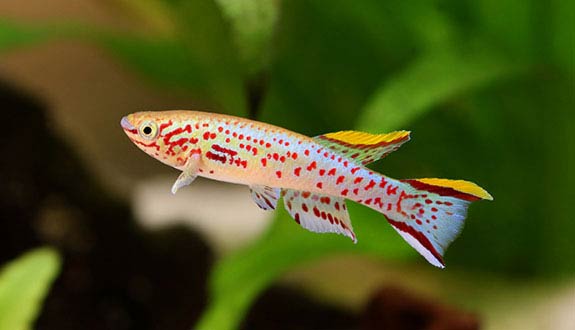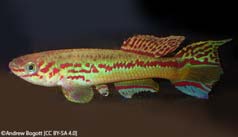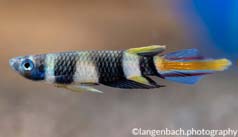

Alternative species (click on the thumbnail to see the card)
Names
Scientific name
Fundulopanchax gardneri
Aphyosemion gardneri
Common name
F.gardneri gardneri: Blue lyretail
F.gardneri lacustris: Ejagham killi
F.gardneri mamfensis: Mamfe killi
F.gardneri nigerianus: Nigerian killi
Origin

Origin: Nigeria, Cameroon
Biotope: African
Dimorphism

Females are much duller than males.
Group
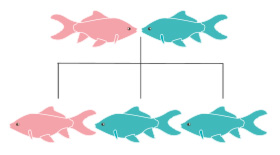
Cynolebiidae (Nothobranchiidae)
Volume

40 L / 9 imp gal / 11 US gal
Parameters

T°: 21 to 25°C or 70 to 77°F
pH: 6.5 to 7
Hardness: 8 to 12°dGH
Difficulty

Easy
Size

Female: 6cm (2.4") - Male: 7cm (2.8")
Longevity

1 to 2 years
Living zone
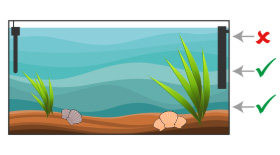
Middle and depth
Individuals

3 (harem)
Food
How to feed the Fundulopanchax gardneri?
Food
How to feed the Fundulopanchax gardneri?
These fish are carnivorous (they hunt larvae and insects in the wild).
In captivity, you will have no difficulty feeding them. Indeed, they accept a wide range of food but will prefer live prey. In general, vary the menus as much as possible to promote their health and colouring. Finally, note that it is better to give them food twice a day in small quantities than to make one large meal.
On the menu (non-exhaustive list):
daphnia (red daphnia strengthen the coloration of fish!)
tubifex
artemia
mosquito larvae
bloodworm
traditional commercial food
All forms of food are accepted: live prey (ideal), frozen (also good) or freeze-dried (as a supplement, sparingly).
Behavior
What kind of behavior does the Fundulopanchax gardneri have?
Behavior
What kind of behavior does the Fundulopanchax gardneri have?
Like all Killies, this species is calm and rather shy (which makes it a perfectly peaceful fish). To make it safe, offer it many hiding places with plants, roots, coconuts... They like to spend time hidden among the Java moss (Taxiphyllum barbieri ) or Singapore moss (Vesicularia dubyana). These plants give them confidence.
The males are tireless seducers, which in the long run can exhaust and weaken the females. To limit this effect, compose a small harem of at least 2 or even 3 females for each male.
Cohabitation
Who can live with the Fundulopanchax gardneri?
Cohabitation
Who can live with the Fundulopanchax gardneri?
Due to its reserved nature, we recommend the maintenance of this species in a specific aquarium. No need for large volumes, for a trio you can choose a 40L / 9 Imp Gal / 11 US Gal nano aquarium.
Maintenance in community aquariums should be done with caution: plan a larger volume and choose only small, very calm fish to live with Fundulopanchax gardneri.
It should never be associated with other Killies species because of the risk of hybridization (which has the long denatured completely "pure" strains). If you have hybrids, do not release them in order to preserve the strains.
Breeding
How to breed the Fundulopanchax gardneri?
Breeding
How to breed the Fundulopanchax gardneri?
The reproduction in aquarium of this species is quite possible. Generally, sexual maturity is reached in fish at least 6 months old.
Although breeding and rearing can be done perfectly well in the main aquarium, you can also facilitate the rearing of young killies by preparing a tank as follows:
water identical to that of the parent aquarium.
egg-laying supports (Java moss, mops...)
small sponge filter on a booster fed by an air pump to ensure water mixing.
You can choose either to isolate a trio (1 male and 3 females) in this aquarium and remove them after laying, or to remove the eggs from the main aquarium and place them in this tank.
However, we recommend that you isolate the adults in the rearing tank because egg laying is quite scattered and decimated throughout the aquarium, which can make it difficult to retrieve all the eggs.
In any case, to stimulate reproduction, raise the temperature to 23°C and feed your breeders small live prey several times a day. Egg-laying should not take long. The female lays her eggs in Java moss or on a mop, which the male fertilizes afterwards. A complete clutch can consist of up to 50 eggs. Depending on the temperature, incubation takes 10 to 20 days.
Fry food: artemia nauplia and microworm nauplia, fry powder.
Its aquarium
Which aquarium for the Fundulopanchax gardneri?
Its aquarium
Which aquarium for the Fundulopanchax gardneri?
In its natural environment, this fish lives in very congested areas rich in vegetation. The water height is quite low and the current almost non-existent.
Ideally, reproduce its conditions in your killies aquarium.
Here are the basics:
lots of vegetation
floating plants for dimming the light
lots of roots and stones for a rugged setting
Dark ground covered with dried tree leaves (beech, oak, catappa...)
aged water
not too much current (or not at all)
lid (excellent jumpers, killies can jump out of their aquarium)
lighting: optional
immersion heater: optional
filter: optional. If you do not put a filter, renew the water regularly (15 to 20% every week) with previously aged water.
To sum up, lighting, filter and immersion heater are not mandatory in the good maintenance of this species. Have you recognized the LowTech technique? It is perfectly adapted to this species!
Good To know
Find all additional information!
Good To know
Find all additional information!
There are 4 subspecies:
Fundulopanchax gardneri gardneri
Fundulopanchax gardneri lacustris
Fundulopanchax gardneri mamfensis
Fundulopanchax gardneri nigerianus
The colour patterns available are closely related to the geographical origin of the populations.
In the wild, Killies are able to "crawl" from pond to pond, sometimes spending long periods out of the water.
Robust and easy to maintain, this species is perfectly adapted to beginner aquarists.
Yours photos!
Comments
Sort by:
Please login to post comments
